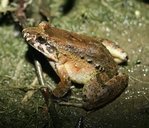|
Leptodactylus colombiensis Heyer, 1994
| family: Leptodactylidae subfamily: Leptodactylinae genus: Leptodactylus |
 © 2011 Andrés Acosta (1 of 4) |
|
|
|
Distribution and Habitat Country distribution from AmphibiaWeb's database: Colombia
Comments This species was featured as News of the Week on 2 August 2021: Most amphibians secrete distasteful or toxic substances from their skin. Several groups wield toxins that can be lethal to other animals, or even to themselves. Animals can evolve resistance to toxins through mutations in proteins that prevent toxins from binding. Although these mutations can provide resistance, they often occur in important regions of a protein, such as those critical to nervous system functions. Thus, a problem arises: how can animals avoid the negative effects of mutations that also provide resistance? A pair of recent studies, one on the toxic salamanders Taricha (Gendreau et al. 2021) and another on frogs of the genus Leptodactylus (Mohammadi et al. 2021), which consume toxic toads, suggest that gene duplication is the key; one gene copy can help animals develop toxin resistance while the other copy maintains a functional nervous system. Both studies also show evidence for a fascinating molecular process known as gene conversion, wherein duplicate copies of one gene retain more similar-than-expected DNA sequences. During homologous recombination, two copies of a genome line up and exchange pieces of DNA; however, when two copies of a gene are near each other in the genome, the wrong genes can line up and exchange genetic material, maintaining genetic similarity between duplicate copies of a gene. In newts, gene conversion appears to have copied resistance-conferring mutations from one gene domain to another. In Leptodactylus frogs, strong natural selection countered the force of gene conversion, resulting in one toxin-resistant gene and one toxin-sensitive gene. How newts and frogs regulate the use of these different gene copies remains unknown and will be an exciting future research topic. (RT) Edited by: Michelle S. Koo (2021-08-01) Species Account Citation: AmphibiaWeb 2021 Leptodactylus colombiensis <https://amphibiaweb.org/species/3316> University of California, Berkeley, CA, USA. Accessed Jul 26, 2024.
Feedback or comments about this page.
Citation: AmphibiaWeb. 2024. <https://amphibiaweb.org> University of California, Berkeley, CA, USA. Accessed 26 Jul 2024. AmphibiaWeb's policy on data use. |



 Map of Life
Map of Life